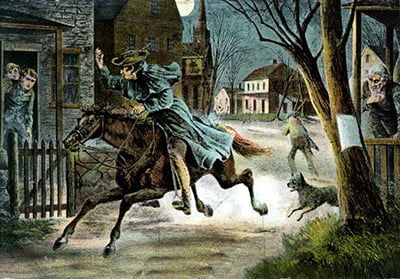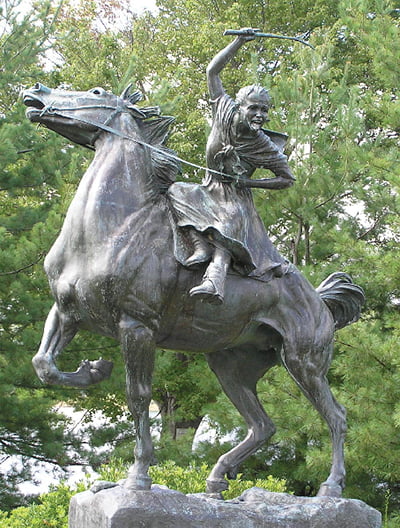
Laura Dean Bennett
Staff Writer
Listen my children and you shall hear, there are more heroes in this story than Paul Revere.
Anyone who came up in the American public school system during the 20th century probably had to memorize Henry Wadsworth Longfellow’s famous 1860 patriotic poem, “Paul Revere’s Ride.”
It s first stanza goes like this:
“Listen, my children, and you shall hear
Of the midnight ride of Paul Revere,
On the eighteenth of April, in Seventy-Five:
Hardly a man is now alive
Who remembers that famous day and year.”
The poem recounts Paul Revere’s midnight ride through the New England countryside, warning that the British were coming.
It transformed Paul Revere from a locally known Boston craftsman and leader of the revolution into a national American folk hero.
Longfellow took several liberties with history in the poem.
As to the warning Revere was shouting, it wouldn’t really have been, “The British are coming!”
That wouldn’t have made sense, since most colonists were British.
His actual words were something like “the Regulars are coming out!”
Revere was the son of a French Huguenot, Apollos Rivoire, a Protestant who left France because of religious persecution.
He was an indentured servant and worked as an apprentice smith. After several years he purchased his freedom for 40 pounds.
Paul was educated at the North Writing School and was taught the art of gold and silversmithing by his father.
When he was 19, his father died, leaving Paul, as the eldest son, to inherit his father’s business and support the family.
Two years later, in 1756, Revere received his commission as a second lieutenant in the Massachusetts artillery and was sent to fight the French in upstate New York during the French and Indian War.
After the French and Indian War, Revere engraved illustrations for books and magazines, business cards, political cartoons, bookplates, a song book and bills of fare for taverns.
His silver shop was the cornerstone of his professional life for more than 40 years, producing pieces ranging from simple spoons to magnificent tea sets.
As a member of the Masonic Lodge of St. Andrew, he was friendly with activists like Dr. Joseph Warren.
In the year before the Revolution, Revere gathered intelligence by “watching the movements of British Soldiers,” as he wrote in a 1798 account of the war.
He was a courier for the Boston Committee of Correspondence and the Massachusetts Committee of Safe- ty, riding “express” several times to the Continental Congress in Philadelphia.
He had long been a revolutionary sympathizer.
As a member of the North Caucus, Revere took part in meetings that planned the destruction of the East India Company Tea in December 1773.
The next day, he spread the word of the Boston Tea Party to New York and Philadelphia.
Revere was a man of great accomplishment, but wasn’t the only one to go on that famous midnight ride in April of 1775.
There were at least three others.
The ride was precipitated when 800 British Regulars marched out of Boston to capture the large cache of provincial military supplies at Concord.
At 10 p.m. on April 18, 1775, Revere and William Dawes received instructions from Dr. Joseph Warren to ride to Lexington to inform John Hancock and Samuel Adams of the British approach, as the Regulars also had orders to arrest them.
Revere crossed the Charles River by boat and rode from Charlestown through Somerville, Medford, Arlington and on to Lexington.
The second rider was another Boston patriot named William Dawes.
Like Revere, Dawes was also a member of the famous patriotic group, the Sons of Liberty, and he was a Freemason.
He traveled south across Boston Neck to Roxbury, then west and north through Brookline, Brighton, Cambridge and Lexington, covering the 17 miles in three hours.
Revere and Dawes managed to warn Hancock and Adams in time for them to make it to safety.
They planned to carry news of the invasion to Concord, where military supplies were stored.
As they left Lexington on their way to Concord, they ran into Samuel Prescott, a country doctor who often made house calls at night.
He was said to have been courting a lady and happened to be leaving her house at 1 a.m.
Spies were everywhere that night, and it must have made for some anxious moments, but the messengers finally recognized Prescott.
As Revere wrote later, Prescott was known to be “a High Son of Liberty.”
He joined them in their dangerous task of alerting households and militia members and pushing on to Concord.
Only Prescott was able to make his way to Concord to alert the townspeople and the militia that the British regulars were coming to confiscate guns and gun powder hidden in a cache there.
Despite the fact that Dawes and Prescott were pivotal in the midnight ride of April 18th, 1775, their contributions were almost completely overshadowed by those of Paul Revere.

On April 26, 1777, another night riding patriot warned of a British attack – this one in Connecticut.
This patriot rode twice as far as Paul Revere.
She was a 16 year old girl named Sybil Ludington.
She was the oldest daughter of Col. Henry Ludington.
On April 26, 1777, she rode 40 miles to muster local militia troops in response to the British burning and sacking of the town of Danbury, Connecticut, and their intended advance through the townships.
An exhausted messenger had been dispatched from Danbury with the news of the attack, and he reached the militia commander’s home at approximately 9 o’clock.
Colonel Ludington needed to organize the militia, but his men had returned to their homes for spring planting and were scattered throughout the area.
The messenger was exhausted and not familiar with the area.
But the colonel’s daughter had her horse, Star, saddled and ready to ride within minutes.
“The Regulars are burning Danbury. Muster at Ludington’s at daybreak!” she shouted at the farmhouses, as she rode through the dark rainy night to Carmel, on to Mahopac, to Kent Cliffs, and from there to Farmers Mills and back home.
When she returned at dawn the next morning, exhausted and soaked from the rain, most of Ludington’s 400 soldiers were gathered to march.
While the regiment could not save Danbury from being burned, they joined forces with the Continental Army following the subsequent Battle of Ridgefield and were able to help stop the British advance and hurry their retreat to the waiting British fleet.
Sybil was personally thanked for her heroism by General George Washington.
In 1935, the New York State Education Department posted historical markers along the probable route of Sybil’s historic ride, and at the Ludington home place.
She was honored on a United States postage stamp.
Dramas, an opera, and an annual marathon have been named for her.
Each April since 1979, the Sybil Ludington 50-kilometer run is held in Carmel, New York.
The course of this hilly road race approximates Sybil’s historic ride, and finishes near a bronze statue of her on her horse, in Carmel, New York.
There is even a poem about her ride, reminiscent of the famous Longfellow poem, although few have heard of it.
“Sybil Ludington’s Ride,” by Berton Braley.
Braley’s poem begins:
“Listen, my children, and you shall hear
Of a lovely feminine Paul Revere
Who rode an equally famous ride
Through a different part of the countryside,
Where Sybil Ludington’s name recalls
A ride as daring as that of Paul’s.”


